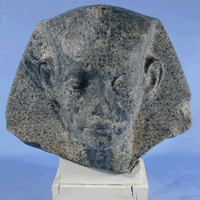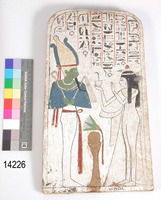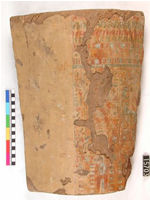


UC 14363
head of small statue of Amenemhat III
UC 14226
wooden stela of Neskhons
UC 15703
fragment of coffin of Amenemipet
The writer Amelia Edwards travelled to Egypt in autumn 1873, to escape the rain on a walking holiday in France. Instantly captivated by the Nile Valley and its ancient and modern histories, on her return she published an account of her travels, A Thousand Miles Up the Nile (London 1877), an immediate success. In the nineteenth century the protection of monuments had only recently begun, and the plight of antiquities inspired Edwards to action. She was uniquely effective in the efforts to raise funds for excavation in Egypt, leaving as her legacy two leading institutions in British Egyptology:
The teaching position was created by bequest: Edwards died in 1892, and in January 1893 her favourite archaeologist in Egypt, William Matthew Flinders Petrie, became the first Edwards Professor of Egyptian Archaeology and Philology, at the age of 39. The bequest was offered to University College London, in preference to Oxford and Cambridge, because at that date UCL was the only place in England where degrees were given to women.
As part of the bequest, Edwards left her collection, the core of what is today the Petrie Museum. Numerically it is overshadowed by the quantity of finds from Petrie excavations, and the collection that Petrie himself formed from his purchases in Egypt and Europe. In the history of science, Edwards predates the development of archaeological techniques of recording information at the moment of finding an object. Precisely for this reason the Edwards collection forms an instructive contrast to the later acquisitions from excavations. In addition to some remarkable highlights, it offers a guide to the general range of material in a standard collection of a mid- to late nineteenth century enthusiast for ancient Egypt.
Three objects of particular importance are known to have been in the collection of Amelia Edwards:
 |
 |
 |
|
UC 14363 head of small statue of Amenemhat III |
UC 14226 wooden stela of Neskhons |
UC 15703 fragment of coffin of Amenemipet |
For other items, the identification as pieces in her collection is complicated by the continued use of the term 'Edwards collection' for the objects in University College London used for teaching Egyptian archaeology and language: many of these were added from excavations and purchases after her death. In 1913 Petrie sold his own collection to the College, and the term 'Edwards Collection' seems to have fallen out of use as inappropriate for this combined resource. Much research needs still to be carried out into the years of accession of items now in the Petrie Museum, to separate its component parts:
1. The Egyptian collection of Amelia Edwards
2. posthumous additions to the Edwards Collection in University College London
3. Other items acquired by University College London
4. The Egyptian collection of W M F Petrie
Disentangling these components is an important task for the history of this collection, within the assessment of relations between Egypt and Europe in the heyday of colonialism.
An early Petrie inventory for the collection in the 1890s or early 1900s
The Petrie Museum archive includes an undated leatherbound book of gilt-edged squared paper, with the title 'Catalogue of Egyptian Antiquities Books &c.' on the front cover. Many pages are blank, but twenty have pasted sheets of paper on which Petrie himself had compiled printed summary information on objects (a duplicate of one page is also present, loose), and another five are full of handwritten entries.
Unfortunately there are few dates of acquisition, though most references on printed pages are to sites visited by collectors or to excavations in the 1880s; this suggests that the focus of the volume is the Edwards collection. Only one item in the printed pages comes from a site excavated substantially later, a blue and black frog figure said to come from Rifeh, not excavated until 1906. Clearly, then, not all items even on the printed pages were already in the collection at the time of her death in 1892. It is also not certain that most or all objects in her collection had been included in the inventory.
The printed pages were designed to be repeatable: for one page there is a loose extra copy in the book. The same block of information on an object might be cut from a duplicate page for use as a label, and when the label and mount survive with the object, it can be identified as probably from the Edwards collection. Theoretically the same block of information might be printed out for more than one object, and new acquisitions of the same form might not be distinguishable.
Despite these complications, the printed pages and briefer handwritten notes on larger items provide a general indication of the range of material ascribed to a separate part of the collection, most likely around the core of the collection of Amelia Edwards herself. Since the Rifeh frog is the only item likely to be from a post-1900 excavation, it is possible that the inventory represents a modestly expanded version of the original inventory of the Edwards collection that Petrie had begun for her during her lifetime.
Assessing the inventory - a task for research
Compare the following summary of the inventory with the vague description by Edwards herself as 'my collection of ancient Egyptian jewellery; scarabs; amulets; statuettes of Deities in porcelain, bronze, and stone; funeral tables; sculptures; pottery; writings on linen and papyrus; and other miscellaneous monuments'. Which of those categories is entirely missing in the inventory?
In Upright Case A
Sets of printed pages which provide the following group headings:
Following these are handwritten pages:
In Upright Case B
Handwritten pages:
first group:
second group:
third group:
Against wall outside of cases
Handwritten page
Most of these items derive from Petrie excavations later than the death of Amelia Edwards
Flat glass case
Handwritten heading 'Scarabs' to first of six printed pages
Some from Naukratis, Lahun ('Kahun'), Gurob, Tell el-Amarna
Source
Petrie Museum archive PMA/WFPI/16/11/1(4)
Copyright © 2003 University College London. All rights reserved.